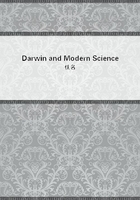
第302章
4.), but his calculations do not enable him actually to draw the state of affairs after the rupture of the neck.
There are certain difficulties in admitting the exact parallelism between this problem and ours, and thus the final development of our pear-shaped figure and the end of its stability in a form of bifurcation remain hidden from our view, but the successive changes as far as they have been definitely traced are very suggestive in the study of stellar evolution.
Attempts have been made to attack this problem from the other end. If we begin with a liquid satellite revolving about a liquid planet and proceed backwards in time, we must make the two masses expand so that their density will be diminished. Various figures have been drawn exhibiting the shapes of two masses until their surfaces approach close to one another and even until they just coalesce, but the discussion of their stability is not easy. At present it would seem to be impossible to reach coalescence by any series of stable transformations, and if this is so Professor Jeans's investigation has ceased to be truly analogous to our problem at some undetermined stage. However this may be this line of research throws an instructive light on what we may expect to find in the evolution of real stellar systems.
In the second part of this paper I shall point out the bearing which this investigation of the evolution of an ideal liquid star may have on the genesis of double stars.
II.
There are in the heavens many stars which shine with a variable brilliancy.
Amongst these there is a class which exhibits special peculiarities; the members of this class are generally known as Algol Variables, because the variability of the star Beta Persei or Algol was the first of such cases to attract the attention of astronomers, and because it is perhaps still the most remarkable of the whole class. But the circumstances which led to this discovery were so extraordinary that it seems worth while to pause a moment before entering on the subject.
John Goodricke, a deaf-mute, was born in 1764; he was grandson and heir of Sir John Goodricke of Ribston Hall, Yorkshire. In November 1782, he noted that the brilliancy of Algol waxed and waned (It is said that Georg Palitzch, a farmer of Prohlis near Dresden, had about 1758 already noted the variability of Algol with the naked eye. "Journ. Brit. Astron. Assoc."Vol. XV. (1904-5), page 203.), and devoted himself to observing it on every fine night from the 28th December 1782 to the 12th May 1783. He communicated his observations to the Royal Society, and suggested that the variation in brilliancy was due to periodic eclipses by a dark companion star, a theory now universally accepted as correct. The Royal Society recognised the importance of the discovery by awarding to Goodricke, then only 19 years of age, their highest honour, the Copley medal. His later observations of Beta Lyrae and of Delta Cephei were almost as remarkable as those of Algol, but unfortunately a career of such extraordinary promise was cut short by death, only a fortnight after his election to the Royal Society. ("Dict. of National Biography"; article Goodricke (John). The article is by Miss Agnes Clerke. It is strange that she did not then seem to be aware that he was a deaf-mute, but she notes the fact in her "Problems of Astrophysics", page 337, London, 1903.)It was not until 1889 that Goodricke's theory was verified, when it was proved by Vogel that the star was moving in an orbit, and in such a manner that it was only possible to explain the rise and fall in the luminosity by the partial eclipse of a bright star by a dark companion.
The whole mass of the system of Algol is found to be half as great again as that of our sun, yet the two bodies complete their orbit in the short period of 2d 20h 48m 55s. The light remains constant during each period, except for 9h 20m when it exhibits a considerable fall in brightness (Clerke, "Problems of Astrophysics" page 302 and chapter XVIII.); the curve which represents the variation in the light is shown in a figure titled "The light-curve and system of Beta Lyrae" (Fig. 7.).
The spectroscope has enabled astronomers to prove that many stars, although apparently single, really consist of two stars circling around one another (If a source of light is approaching with a great velocity the waves of light are crowded together, and conversely they are spaced out when the source is receding. Thus motion in the line of sight virtually produces an infinitesimal change of colour. The position of certain dark lines in the spectrum affords an exceedingly accurate measurement of colour. Thus displacements of these spectral lines enables us to measure the velocity of the source of light towards or away from the observer.); they are known as spectroscopic binaries. Campbell of the Lick Observatory believes that about one star in six is a binary ("Astrophysical Journ." Vol. XIII. page 89, 1901. See also A. Roberts, "Nature", Sept. 12, 1901, page 468.); thus there must be many thousand such stars within the reach of our spectroscopes.
The orientation of the planes of the orbits of binary stars appears to be quite arbitrary, and in general the star does not vary in brightness.
Amongst all such orbits there must be some whose planes pass nearly through the sun, and in these cases the eclipse of one of the stars by the other becomes inevitable, and in each circuit there will occur two eclipses of unequal intensities.
It is easy to see that in the majority of such cases the two components must move very close to one another.